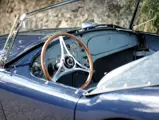Est. 150 bhp, 2,553 cc Ford-Zephyr OHV inline six-cylinder engine with triple SU carburettors, uprated Ford manual transmission, independent front and rear suspension with transverse leaf springs and wishbones, and front disc and rear drum brakes. Wheelbase: 2,286 mm
The John Tojeiro-designed AC Ace was styled after the prototype, LOY 500 (itself modelled after the Carrozeria Touring-clad Ferrari 166 MM Barchetta), and it is considered to be one of the most beautiful sports roadsters of all time. To many, the cleanly styled alloy-bodied Ace was arguably even more handsome than the prototype, and it could certainly stand on its own merits. When the AC Ace appeared in 1953, it was built on a ladder-type frame of parallel three-inch steel tubes, a centre crossmember, and triangular sheet steel boxes at each end, which served as location points for the simple but effective independent transverse leaf/wishbone suspension, and it featured rack-and-pinion steering and a final-drive unit.
The new Ace was powered by the company’s own venerable two-litre, overhead-camshaft, six-cylinder engine that could produce 102 brake horsepower with three side-draught carburettors. Early Aces were also fitted with Alfin drum brakes at both ends, whilst later cars had Girling disc brakes at the front. Two master cylinders were also used, which was an early application of this safety system. The Ace was capable of reaching “the Ton” with little effort.
Shortly after production commenced, auto dealer and racing driver Ken Rudd installed a Bristol (ex-BMW) overhead-valve, triple-carburetted six that offered a healthy 120-plus brake horsepower, and it proved extremely well suited to competition. In 1957, realising that the Bristol motor was a vast improvement over its own engine, AC owner Charles Hurlock immediately adopted that variant. However, when the supply of Bristol engines dried up in 1961, Rudd, the owner of the very successful racing shop Ruddspeed, proposed that AC adapt the widely available 2.6-litre Ford-Zephyr Mk II inline six to the Ace’s chassis. The factory at Thames Ditton concurred, and the handsome little roadster gained new life, at least for a short while.
The Ford six had a lot going for it. Its over-square dimensions of 82.5x79.5 millimetres allowed high engine revs, and the water-jacketing around each cylinder ensured efficient cooling and excellent durability. Ruddspeed offered several tuned variations of the engine, up to and including the Stage 5, which included a triple-Weber-carburetted, aluminium 12-port cylinder head designed by Raymond Mays, who was perhaps best known for his success at the wheel of ERA single-seaters.
Indeed, in the 7 July 1961 issue of Autosport, John Bolster’s road test of a car with the same specification as this example pronounced it as “simply breath-taking”. Furthermore, as the car recorded a 0–60 sprint in 7.2 seconds, 0–100 in 19 seconds, and a maximum speed of 120 mph, it was also described in the article as “stupendous!”
In late 1963, after some 37 examples had been built, the creation of the Cobra, with a small block Ford V-8 stuffed into the Ace chassis by Californian Carroll Shelby, resulted in the demise of the Rudd-inspired Ace 2.6. Thus, the Zephyr-powered series was the final development and rarest derivative of the iconic Ace.
This very attractive Ace, chassis AEX 1174, was originally fitted with an AC engine and finished in black over red trim. It was delivered on 15 August 1960 and then shipped to its first owner, a Mr Betts of New York. By 1981, the car had joined the collection of well-known British car collector and AC enthusiast Dean Versaw, of Fountain Hills, Arizona. A copy of an article from the Arizona Republic described him as “well known in the Valley’s thriving British car community for his unflagging enthusiasm and participation in scores of rallies and events. And Versaw has the mechanical skills to care for his cars, knowing each one of them from bumper to bumper. ‘I’ve had every one of these cars apart…I’ve had my hands in all of them’”.
Versaw owned three other ACs of various vintages, and he was an area representative for the AC Owners Club. During the course of a full restoration, Mr Versaw had the opportunity to purchase and install one of the original AC Ruddspeed-modified Ford-Zephyr engines. The engine was a Stage 4 unit topped with a Raymond Mays alloy 12-port cylinder head and triple SU carburettors. The Mays conversion is appropriately announced with the correct Rubery Owen and Company Ltd. data plate that came with the transplanted motor. With its light weight (less than 770 kilograms), its Girling front disc and large rear drum brakes are very effective in hauling the car down from speed.
AEX 1174 was totally restored and used extensively by Versaw on AC Club gatherings and rallies across the U.S. and in Europe. It is currently presented in Navy blue over a light blue interior, and beneath the bonnet is a lovely polished Ruddspeed valve cover that tops the Zephyr inline six, with its row of three large SUs attesting to its potency. This example is fitted with chrome-plated knock-on wire wheels, and it is supplied with Plexiglas sliding side curtains. The dark blue tonneau cover and removable soft-top with its frame are in good condition. Accompanying the car is a correct spare wire wheel and tyre, as well as a substantial file of paperwork pertaining to the rebuild, a sundry of other documents, and the aforementioned copy of the period Autosport road test.
The AC enthusiast seeking a beautifully restored and very usable Ace roadster need look no further than AEX 1174.
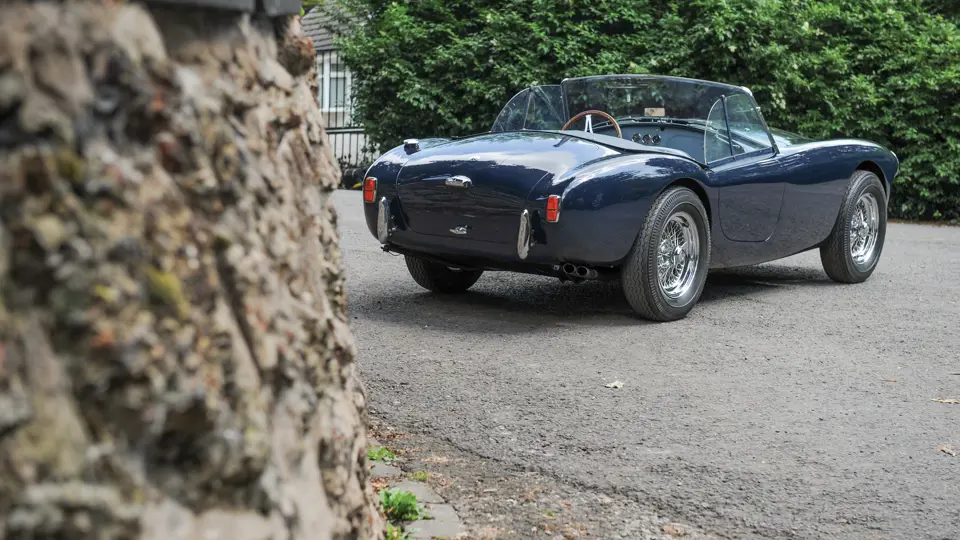
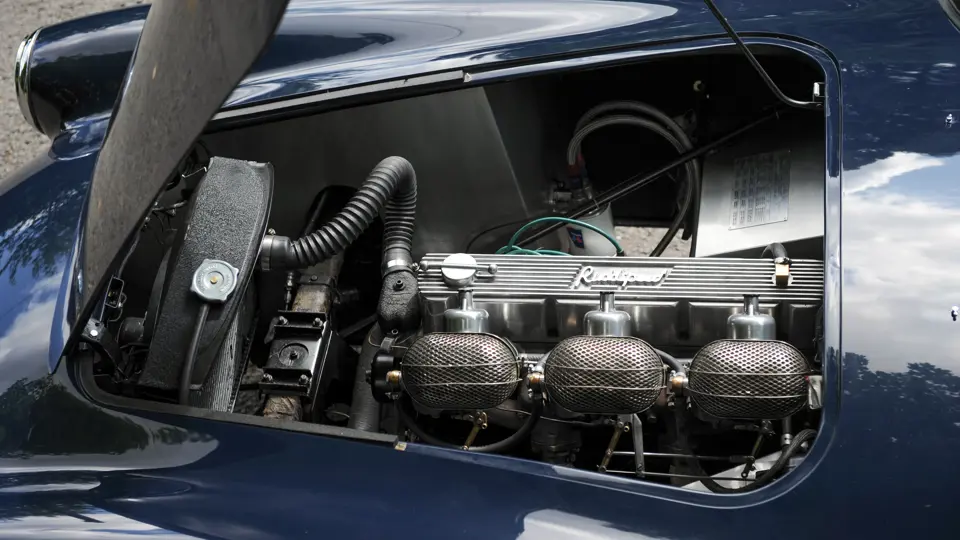









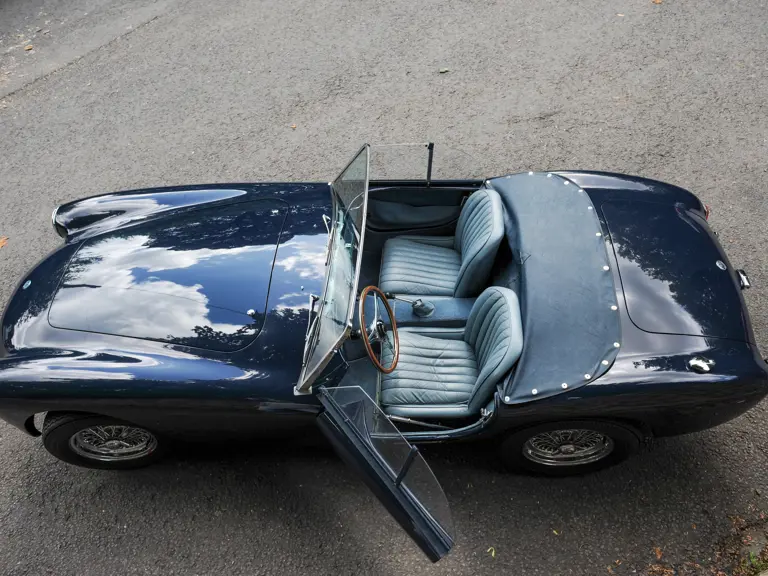

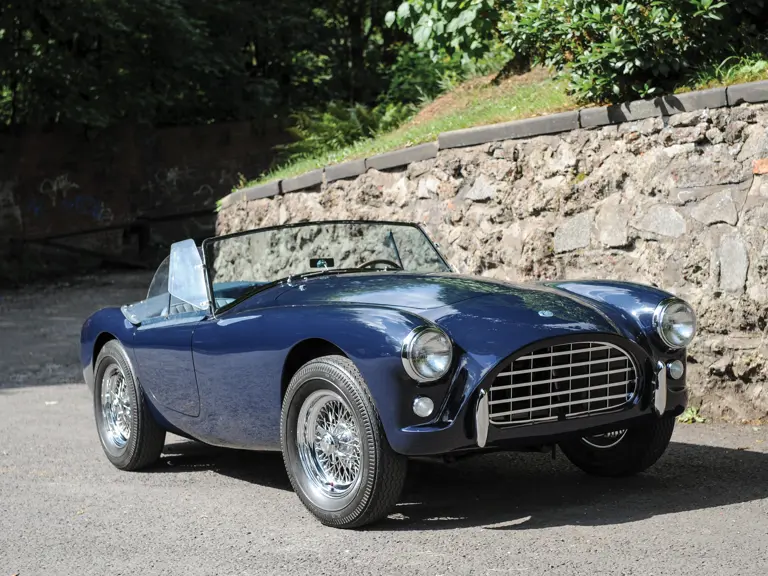






 | London, United Kingdom
| London, United Kingdom













